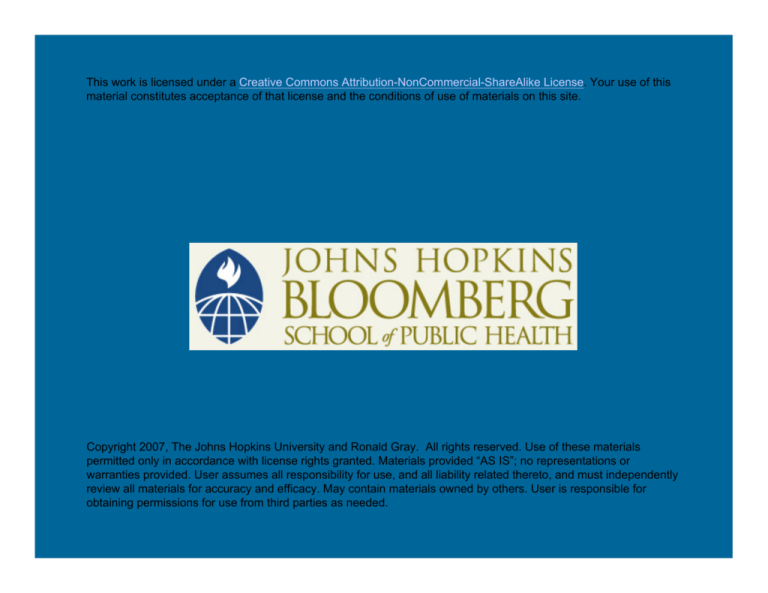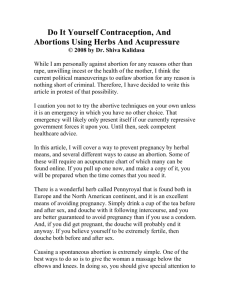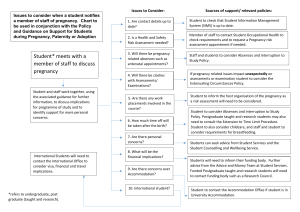
This work is licensed under a Creative Commons Attribution-NonCommercial-ShareAlike License. Your use of this
material constitutes acceptance of that license and the conditions of use of materials on this site.
Copyright 2007, The Johns Hopkins University and Ronald Gray. All rights reserved. Use of these materials
permitted only in accordance with license rights granted. Materials provided “AS IS”; no representations or
warranties provided. User assumes all responsibility for use, and all liability related thereto, and must independently
review all materials for accuracy and efficacy. May contain materials owned by others. User is responsible for
obtaining permissions for use from third parties as needed.
Lecture 2
Conception and Pregnancy
Loss
Lecture Objectives
• Probability of conception and fecundability
• Pregnancy loss, factors influencing
pregnancy loss
• Select appropriate epidemiologic measures of
pregnancy loss
• Lactational amenorrhea
Time line of conception and birth outcomes
Conception
Infertility
Fetal development
Pregnancy loss
Birth outcomes
Stillbirth
Reduced fetal
growth
Birth defects
preterm birth
/low birth weight
Infant mortality/morbidity
Fertilization & Probability of Conception
• Fertile life of gametes: in humans unknown,
probably
– sperm ~ 24-48 hours,
– ovum ~ 12-24 hours.
• Fertile time in each cycle ~ 30-66 hours
• Maximum probability of conception occurs
with intercourse on day of ovulation or 1-2
days prior to ovulation
Conception & Day of Ovulation (0)
Probability of conception
0.4
0.35
0.3
0.25
0.2
0.15
0.1
0.05
0
-6
-5
-4
-3
-2
-1
Day
Source: Wilcox et al. New Engl J Med 1995;333:1517-1521.
0
1
Frequency & Timing of Intercourse
• Frequency and timing of intercourse
determines the probability of conception per
cycle
• Frequency of intercourse decreases with age,
duration of marriage, culture and phase of the
menstrual cycle (highest around time of
ovulation)
Coital frequency per Month
Coital Frequency per Month by
Age
11
10
10.02
8.98
9
9.11
8
7.44
7
6
5
4
15-24
Rakai, Uganda Gray et al Lancet 2001
25-29
Age
30-24
35-59
Proportion of women reporting
coitus
Coitus and Time of Ovulation
*
0.7
0.6
0.5
0.4
0.3
0.2
0.1
0
-10
-9
-8
-7
-6
-5
-4
-3
-2
-1
OF
D ay r elat ive t o o nset o f LH sur g e ( d ay O F )
F o llicular
OL
1
2
3
4
5
6
7
8
9
D ay r elat ive t o LH p eak ( D ay OL)
Lut eal
Source: Udry JR in Biomed Demographic Determin Reproduction
10
Timing of Intercourse and Sex Ratio
• Timing of conception may affect sex ratio:
– Female births more common in conceptions closer
to time of ovulation
– Female births more common with ovulation
induction
– Suggestion that high gonadotrophin levels may
increase motility of X bearing sperm?
– Not much use for sex selection
– May explain higher male sex ratio in baby booms
following wars
Probability of conception
• Probability of conception per month or fecundability
(F).
• F ~ 0.25/month, depending on age, frequency and
timing of intercourse (highest ~ 0.35)
• Use of waiting times to pregnancy (Wt) as a measure
of fertility
• F ~ 1.5/ Wt
– Baird et al Amer J Epidemiol 1986
Why is the probability of conception
so low?
• Failure of ovulation (age, stress etc)
• Failure of fertilization (timing of intercourse,
defects in sperm or ova)
• Failure of implantation
• Early pregnancy loss (EPL)
Waiting Time to Conception
• Waiting time to conception is ascertained in
women who are not contracepting
– Information ascertained retrospectively or
prospectively by two questions:
• “Did you get pregnant during the first
month of unprotected intercourse?”. If
not,
• “How many months (cycles) did it take
for you to become pregnant?”
Analysis of probability of conception
• Waiting time to conception is useful for
identification of reproductive hazards or
impairment (e.g. caffeine, smoking, nitrous
oxide, injectable contraception, HIV)
• Analysis: Cumulative probability of
conception (Kaplan-Meier), proportional
hazards (Cox) model for multivariate
adjustment
Cumulative Probability of Pregnancy
• Cumulative probability of conception per year:
– Ages 20-29 years, cumulative probability of
pregnancy within one year ∼ 90-95%
– Ages 30-39 cumulative probability ∼ 70-80%
– Failure to conceive > 1year, probability 49%
– Failure to conceive > 2 years probability 14%
– Affects clinical and epidemiologic definition of
infertility
Cumulative Rate of Pregnancy with Nitrous
Oxide Exposure in Dental Assistants
100
90
Pregnant (%)
80
70
60
50
40
30
20
10
0
0
1
High unscavenged
Low scavenged
Low unscavenged
2
3
4
5
Unexposed
High scavenged
6
7
8
9
10
11
Menstrual cycle
Source: Rowland et al. New Engl J Med 1992;327:993-997.
12
13
Smoking and delayed conception
• Biology:
– Products of tobacco smoke (benzopyrene,
cadmium, cotinine) reach the ovarian follicle and
reduce fertilizing ability of the oocyte,
– reduces ciliary activity of fallopian tubes affecting
ovum transport
– Smoking accelerates estrogen metabolism,
reduces ovarian response to FSH/LH,
• Conceptions within 12 months
–
–
–
–
Non-smokers
Passive smokers
Active smokers
Active + passive
89.7%
89%
86.2%
85.8%
– Hull Fertil Steril 2000; 75:725
Pregnancy Loss
• Epidemiology and biology of subclinical
and clinical pregnancy loss
• Levels and determinants and methods
of measurement of spontaneous
abortion
• Pregnancy loss as a marker for
environmental hazards
Pregnancy Loss
• Pre-implantation
– Loss of a fertilized ovum prior to implantation (e.g.
<7 days post-fertilization), cannot be detected in
epidemiologic studies.
• Subclinical Early Pregnancy Loss (EPL)
– Loss before a recognized missed menses.
Detected by hCG level between implantation (∼ 7
days after fertilization) and menses.
Measurement of Early Pregnancy Loss
(EPL)
• Early pregnancy losses (EPLs) identified by
prospective urinary hCG assays using ultrasensitive and specific sandwich
immunonassays for hCG (avoids crossreaction with midcycle LH)
• Daily urine samples during the second half of
the luteal phase of the cycle (after
implantation) and during menstruation (∼ 12
days)
Rate of Early Pregnancy Loss (EPL)
• Four prospective studies >1000 women
and 3000 cycles (Wilcox NEJM 1988, Zinaman Fertil Steril
1996, Hakim Amer J Obstet Gynecol 1995, Wang Fertil Steril 2003)
• EPL ∼ 23% in normal women
• Rate of EPL increases with more cycles prior
to recognized conception (e.g., EPL >35%
with >6 cycles)
• In women with a subfertility history EPLs ∼
70% (RR = 2.6) Hakim et al Amer J Obstet Gynecol 1995
Early pregnancy loss and spontaneous
abortions associated with serum DDT
(Venners et al. Amer J Epidemiol 2005;162:709)
DDT levels
Early pregnancy Loss
Spontaneous
abortion
Rate %
Adj RR
Rate %
Adj RR
Low
19.0
1.00
10
1.0
Medium
24.0
1.2
(0.7-2.1)
10
1.2
(0.5-1.3)
33
2.12
(1.3-3.6)
10
1.3
(0.5-3.1)
High
Linear trend
10ng/g
1.2
(1.1-1.3)
1.1
(0.9-1.3)
Spontaneous Abortion
• Spontaneous abortion (SAB)
– Loss of a recognized pregnancy after a
missed menstrual period (e.g. > 4 weeks
after the last menstrual period) and before
the age of extra-uterine viability (usually up
to 20th week gestation).
Pregnancy Loss
• Stillbirths
– deaths of a fetus after time of viability ∼ 21
weeks gestation (variable definition used.
WHO definition for international
comparisons 28+ weeks).
• Induced abortions
– purposeful termination of pregnancy at any
gestation
– Often concealed or poorly reported
Measurement of SAB
• Interviews of pregnant women (prospective)
– Depends on age at gestation at time of interview
• Interviews of women about prior pregnancies
(retrospective)
• Problem: omits early pregnancy losses, and
recall errors (omissions or timing)
– 82% SAB recall accuracy < 10 years (Wilcox et AJE)
Measurement of SAB
• Spontaneous abortion (SAB) rates measured as
percent of pregnancies lost, or as a life table rate
– Adjustment for competing risks of induced abortion or
ectopic pregnancy (adjust N x 0.5)
– Adjust for time in gestation when pregnancy first
observed (fusion cohort)
– Cumulative rate of SAB ∼10-20% of recognized
pregnancies, rates higher in early pregnancy and age
> 35
Risk Factors for Pregnancy Loss
• Damage to the gametes (particularly ova),
disruption of fetal development or of
placenta/uterine unit
• Age: SABs increase after age 35 due to ovum
abnormalities
– Ovum donation from young women to older
recipient decreases SABs. Therefore age
of ovum not age of the woman is critical.
Spontaneous Abortion Rate by Age (IVF
with own or donor ova)
Ovum donated by
young women
70
Spontaneous abortion (SAB) rate
50
Pregnancy
rate 35%
40
30
Pregnancy rate
20
10
0
Age (years)
1
~4
9
~3
7
~3
5
~3
3
~3
1
~3
9
~2
7
~2
5
~2
5
40+
<2
Percentage (%)
60
SAB rate
36.4%
Risk Factors for Pregnancy Loss
• Chromosomal abnormalities and SABs
– Chromosomal anomalies, ~60% in SABs and ∼5%
in stillbirths
– Anomalies (trisomy) of larger chromosomes
incompatible with life cause SAB earlier in
gestation.
– Smaller chromosomes (e.g., 21 Downs syndrome)
are compatible with life and lost later in gestation
• Increased SAB incidence with age involves
both chromosomally normal and abnormal
fetuses
SAB Rates by Age and chromosomal
abnormalities
60
Spontaneous abortions
spont abortions + livebirths
Percent
50
40
Euploid abortions
euploid abortions + livebirths
30
20
Trisomic abortions
spont abortion + livebirths
10
0
~14
~19
~24
~29
~34
~39
~44
Maternal age at last menstrual period
Estimated rates (%) of spontaneous abortion, euploid
abortion and trisomic abortion by maternal age for public patients
Risk Factors for Pregnancy Loss Contd.
• Recurrent or prior spontaneous abortions
– Due to physical, immunologic, timing of
conception and endocrine factors
• Infections
– STDs (particularly syphilis and HIV)
– Malaria (fever, placental parasitemia)
– Febrile or chronic illness / malnutrition
• Occupational / environmental exposures
– e.g. glycol ethers, solvents, heavy metals,
pesticides
SABs and timing of Conception
35
SAB Rate (%)
30
25
*
*
20
171 women with
a history of
pregnancy loss
15
10
694 women with
no prior
pregnancy loss
5
0
< -3
_ -2
_ -1
> 1+
Day of conception (estimated day of ovulation = 0)
Gray Amer J Obstet Gynecol
Risk Factors for Pregnancy Loss Contd.
• Behavior
– Smoking, alcohol, stress, caffeine
– Infertility: SABs are more frequent in
women with prolonged waiting times to
conception
– Subclinical losses are more frequent in
women with subfertility
• IUDs
– Pregnancy with IUD in situ
Lactation and Lactational Amenorrhea
• Prevalence and duration of lactation,
time trends, and differentials
• Endocrinology of lactational
amenorrhea and infertility. Effects of
feeding patterns and maternal nutrition
• Lactational Amenorrhea Method (LAM)
of contraception
Biology of Lactational Amenorrhea
• Suckling stimulus to nipple → CNS causing:
• Stimulates prolactin (hPrL) from pituitary →
increasing milk production
• Inhibition of GnRH pulses → FSH and LH
suppression → anovulation and
amenorrhea
Suckling Stimulus
• Effects depend on frequency and duration of
suckling episodes, intensity of suckling and
duration of time postpartum (responsiveness
diminishes with longer duration)
• In traditional societies mothers often sleep
with infant at the nipple, persistent nocturnal
stimulus
Factors Affecting Lactational Amenorrhea
(LAM)
• Poor maternal nutrition may increase the
duration of LAM by reinforcing the feedback
inhibition, or because reduced milk volume
may promote more vigorous infant suckling
• Maternal illness
• Infant illness (failure to suckle)
• Oral contraceptives suppress milk production
(estrogen effect)
• Nocturnal suckling
Lactational Amenorrhea Method (LAM) for
Postpartum Contraception
• Many societies traditionally used LAM for
birth spacing
• LAM as a contraceptive method is a decision
tree
– Amenorrhoeic
– Exclusive or almost exclusive breastfeeding
– No bottle supplements
• Efficacy: pregnancy rates ~0.5% < 6 months
postpartum
• After 6 months, less reliable
Supplemental Feeding and Weaning
• Supplements needed after 4-6 months to
maintain infant nutrition
• Bottle, cup or spoon feeds
• Bottles displace breast (babies satiated)
• Weaning determined by culture, maternal
demands of illness (mother or infant)
• Weaning reduces suckling stimulus causing
resumption of ovulation and menses
Average supplementary feeds for day
Average Daily Breastfeeds by
mode of feeding
6
BOTTLE
SOLIDS
CUP
5
4
3
2
1
0
1
3
5
7
9 11
1
3
5
7
9 11 1
3
5
7
Average Daily Breastfeeds
Source: Campbell and Gray. Am J Obstet Gynecol 1993; 169(1):55-60 .
9
Frequency of Supplementary Feeding
• Most mothers supplement breast milk,
even in societies with almost universal
breast feeding
• Exclusive breast feeding ~ 30% at 4
months, 5-6% at 6 months (in 14
developing countries)






